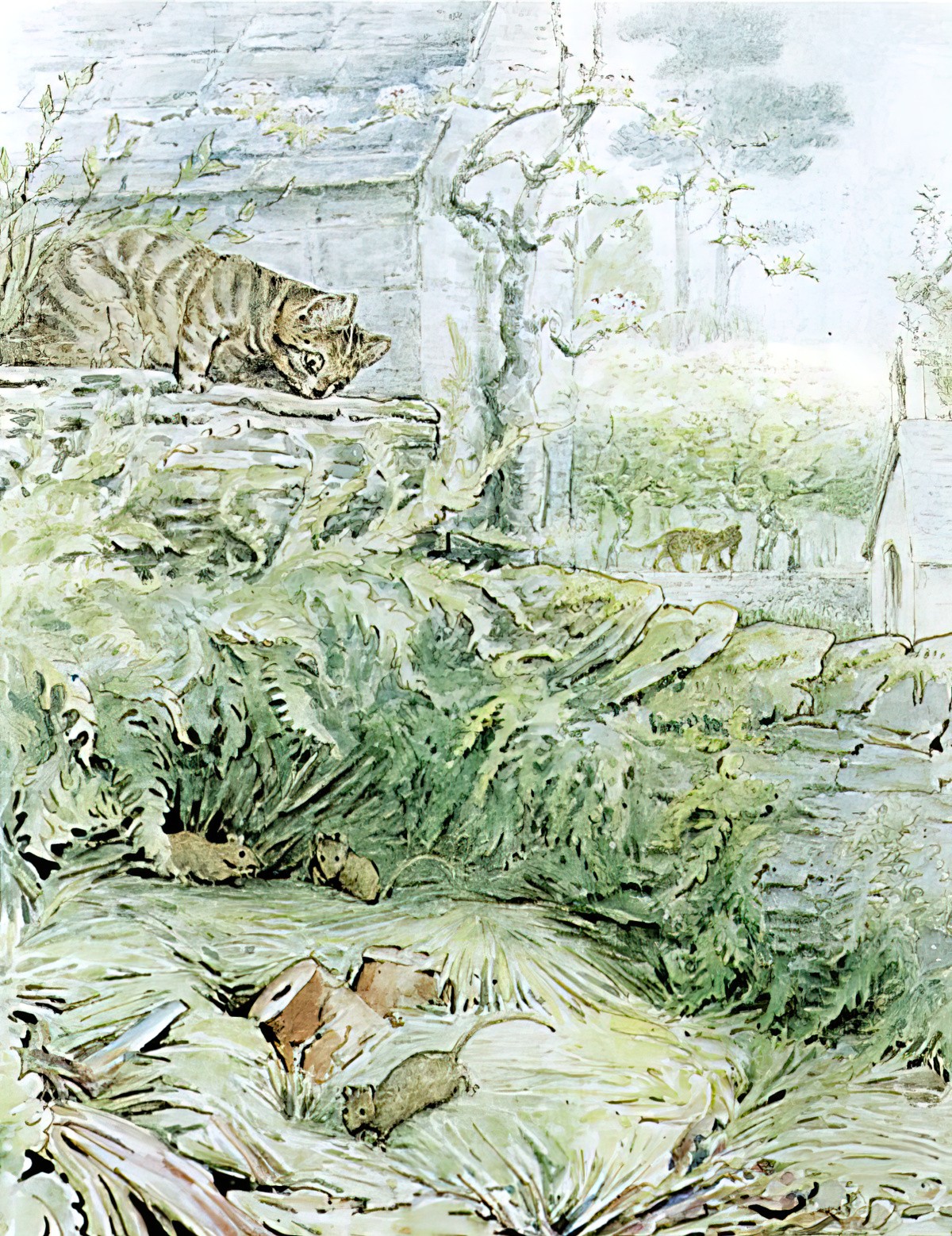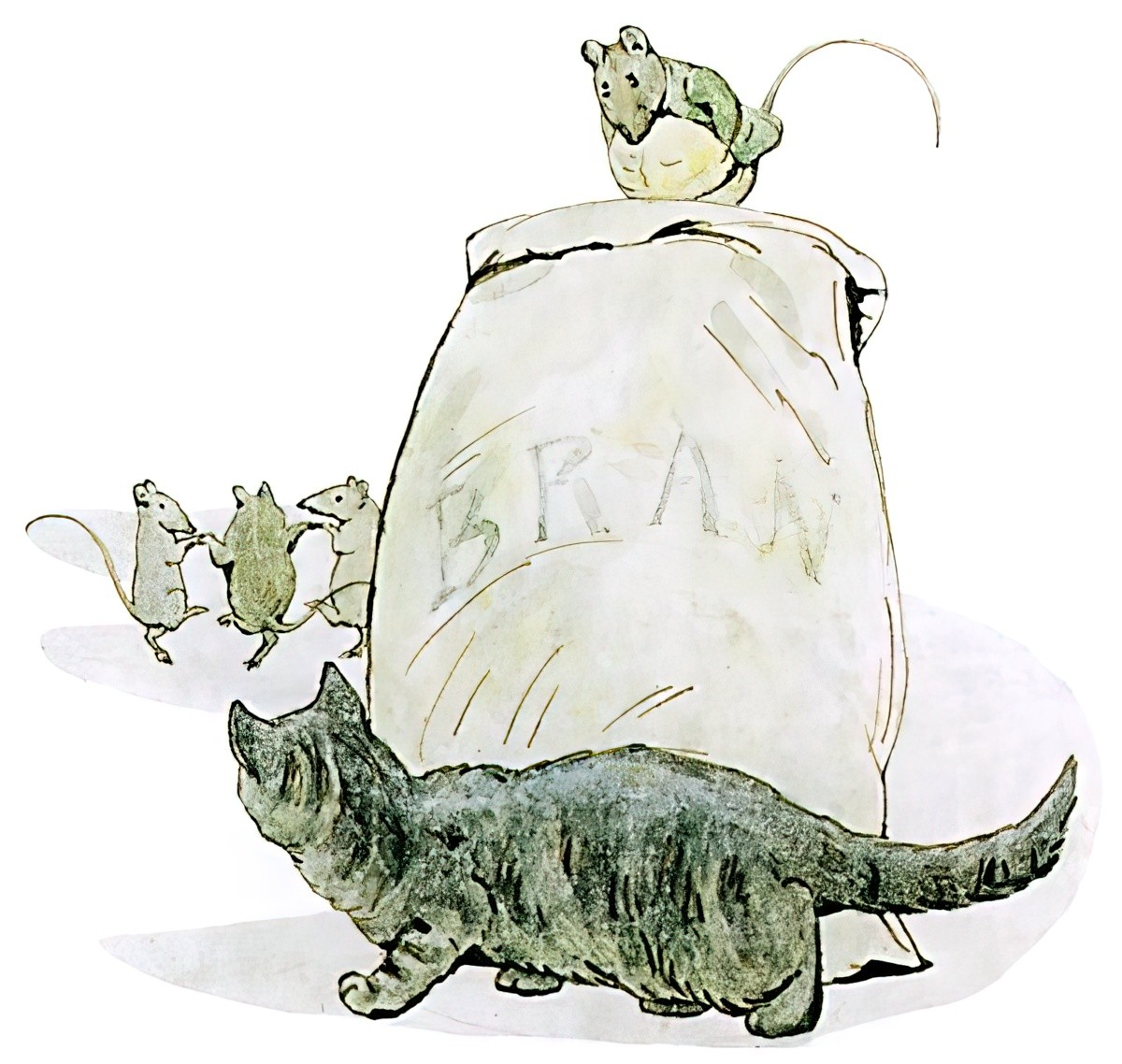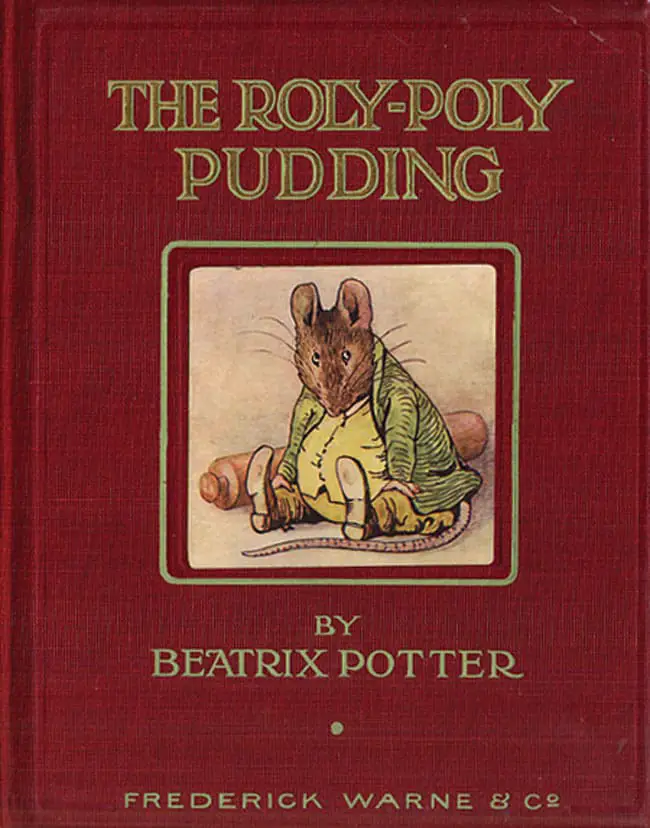The Tale of Samuel Whiskers by Beatrix Potter was originally called The Roly-Poly Pudding and written as a Christmas present to a child. Potter’s image of the cat rolled up in dough is one of those resonant illustrations which, once seen, can never be unseen. Perhaps this image scarred you, too, as a child.
Perhaps it scars you now.
What makes an image resonant? I’ve explored that question elsewhere. Honestly, you can turn cosy Beatrix Potter illustrations into horror with a bit of cropping:
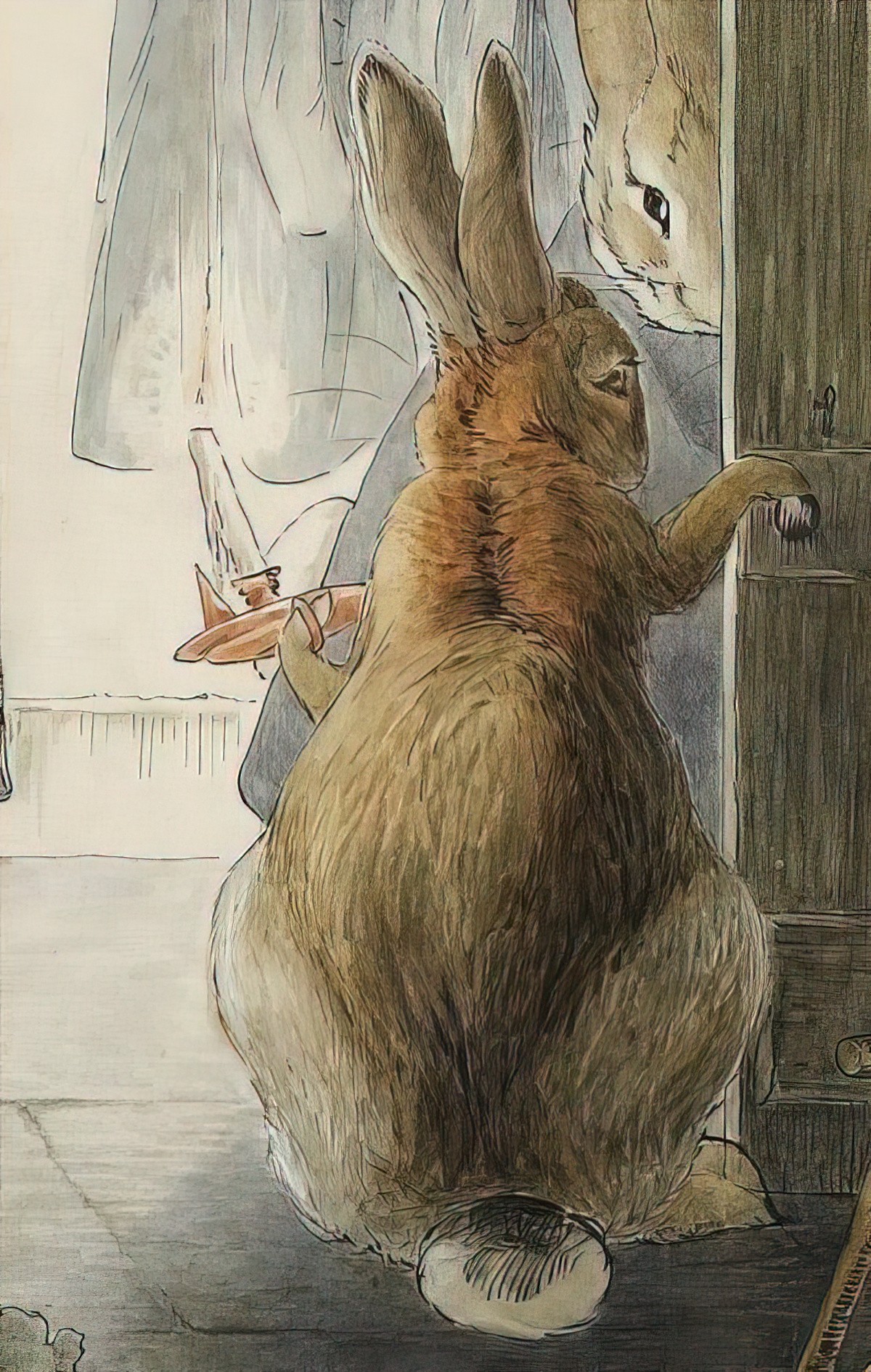
In any case, I’m not surprised Potter originally used the story’s most scarring imagery as the original title, and I’m also not surprised that the title was changed. It wasn’t exactly in keeping with the rest of the Beatrix Potter books.
STORY STRUCTURE OF THE TALE OF SAMUEL WHISKERS
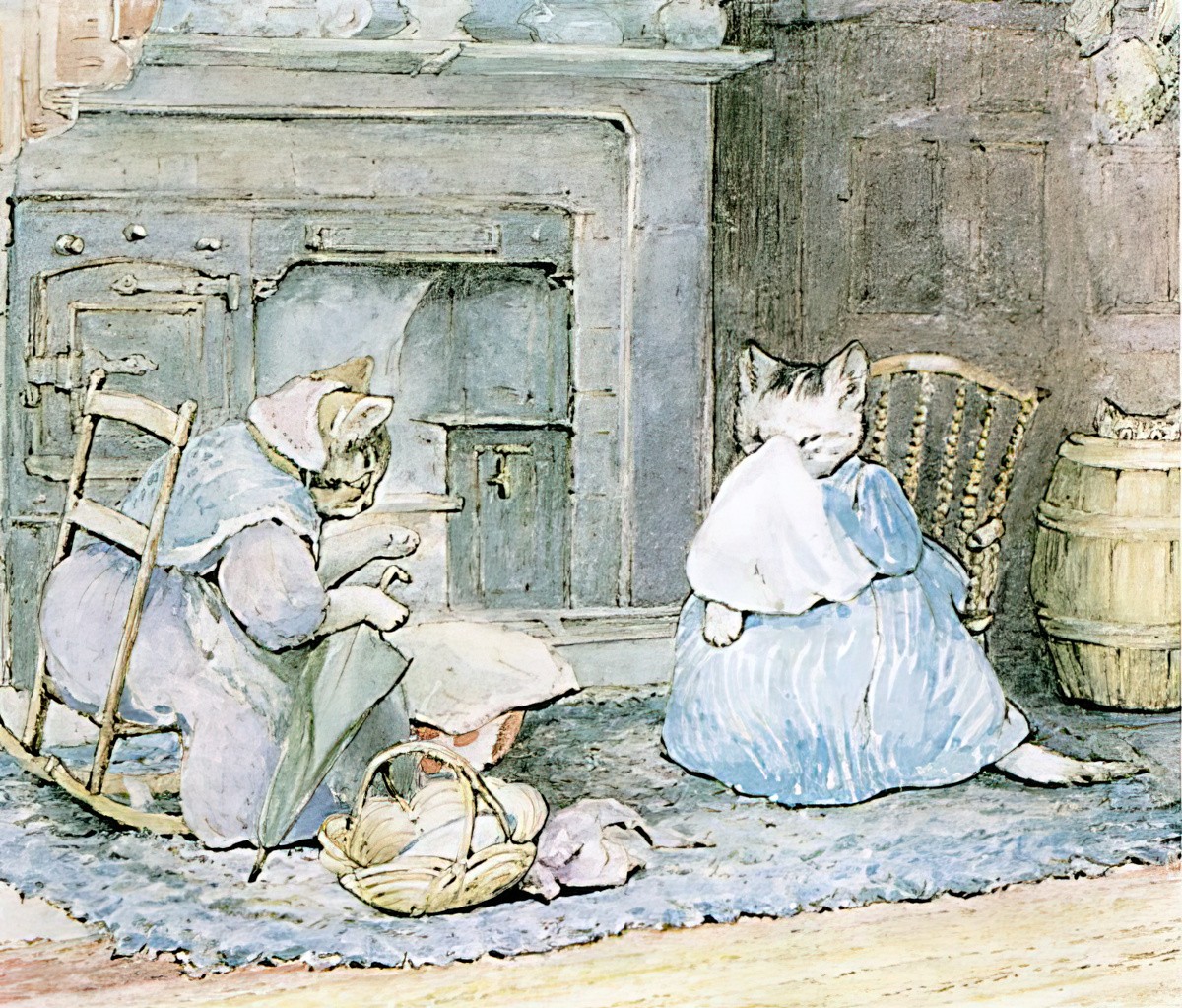
Reading through the Beatrix Potters is like watching a series of wildlife documentaries — watch the one about the lions and you’re rooting for the lions. Watch the one about the deer and you’re rooting for the deer, and mad at the lions for killing the deer.
The Tale of Samuel Whiskers places reader empathy firmly with the cats, in contrast to The Tale of Johnny Town-mouse, in which the cats in a big Edwardian house are positioned as horrific enemies.
Samuel Whiskers has its own version of horror, not least the ‘spatial horror‘, which needs its own entry on TV Tropes. Spatial horror is very much a part of Beatrix Potter’s oeuvre. I’d hazard a guess Beatrix did not like to be locked up in tight spaces and hated feeling giddy and disorientated. The onomatopoeic ‘roly poly’ of the pudding is in itself a type of spatial horror.
I suspect Beatrix Potter’s form of spatial horror derived from the stories of chimney sweeps. Beatrix was born in 1866. At that stage, the brutal practice of using small children as chimney sweeps had not yet been outlawed. The law finally changed in 1875 after a 12-year-old called George Brewster became wedged in chimney while cleaning at a hospital. He died from suffocation. Note that Beatrix Potter was about the same age as George. I’d wager Beatrix saw this news and was disturbed by it.
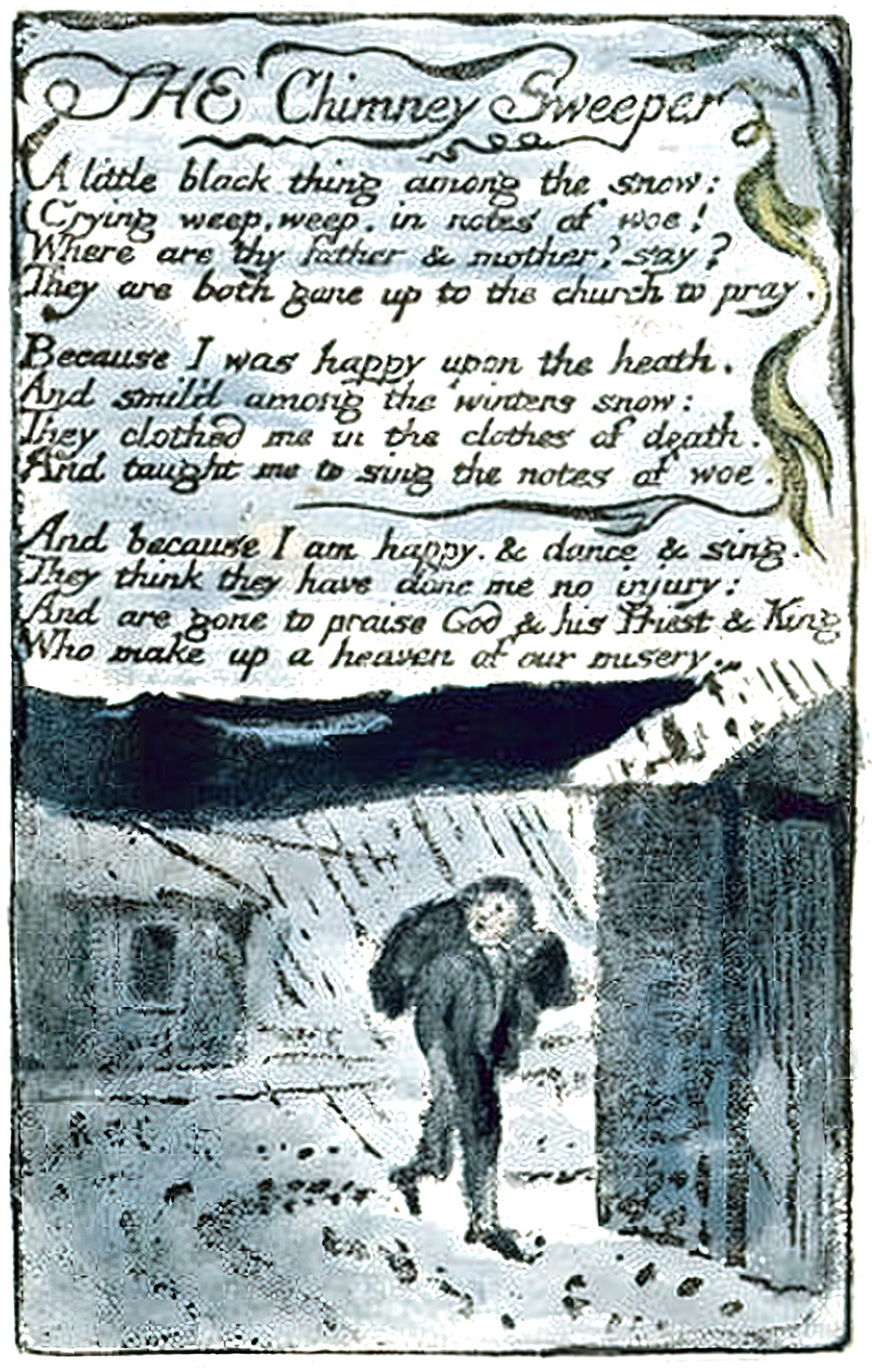
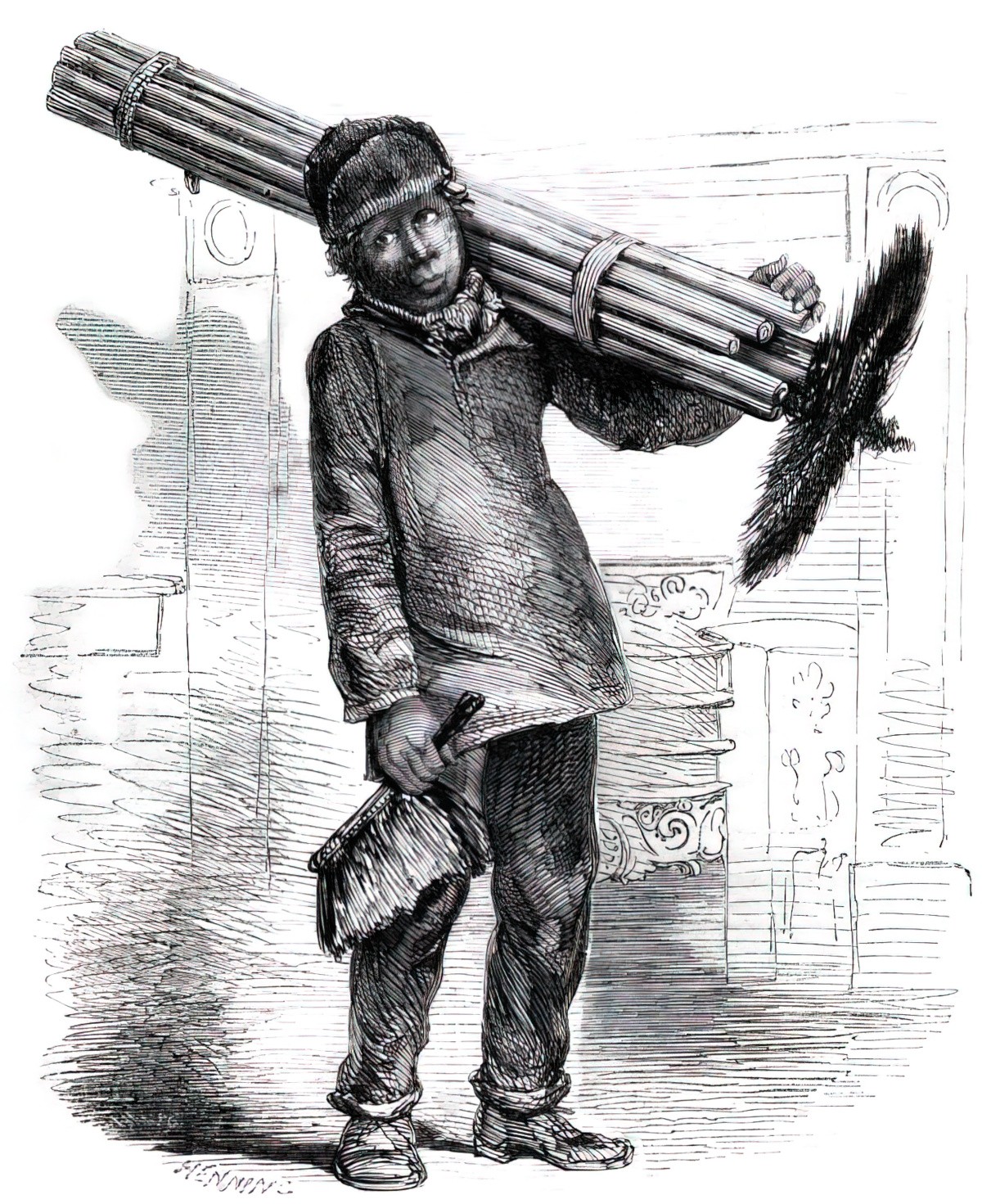
SHORTCOMING
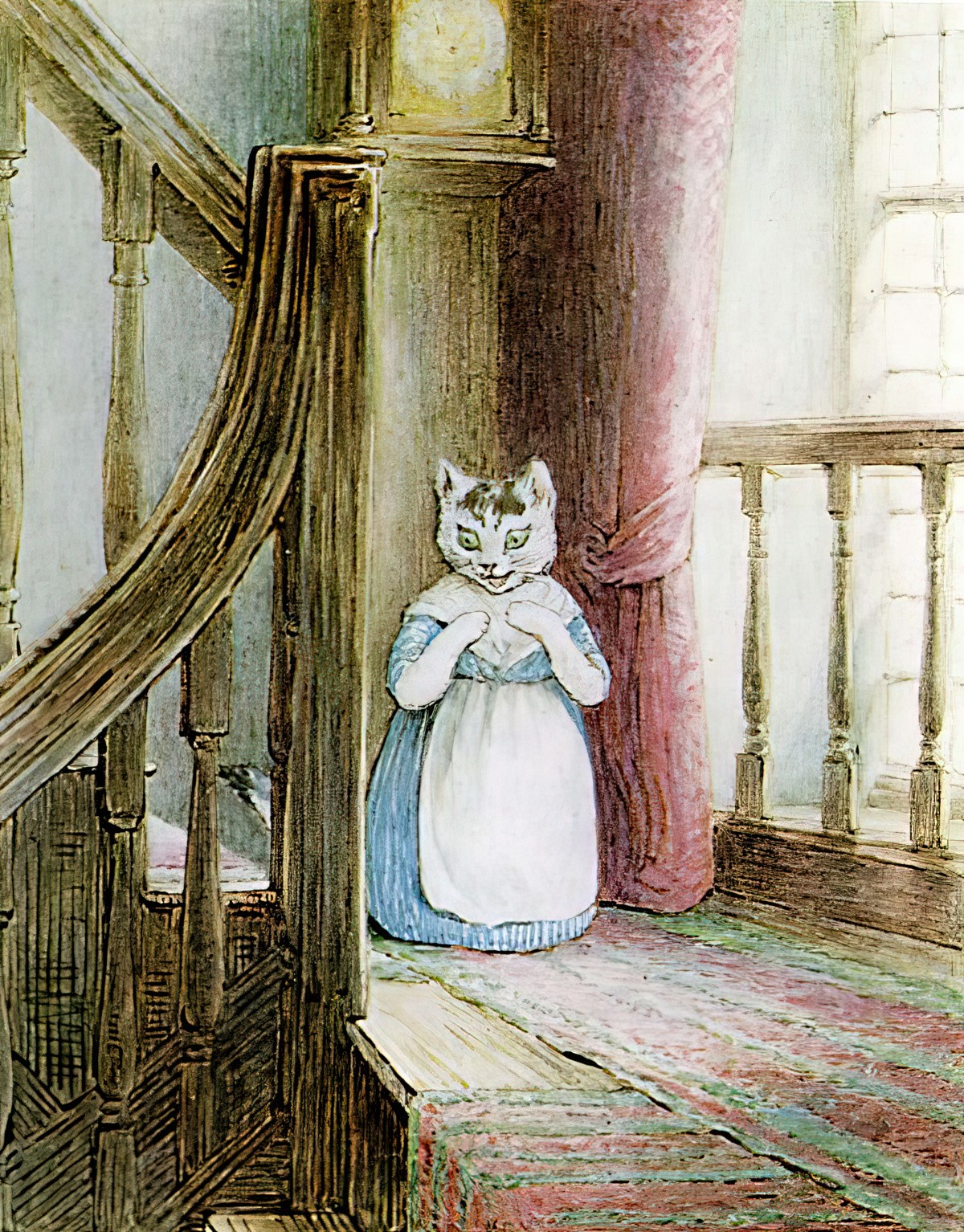
The story of Samuel Whiskers starts off with the problem of a mother cat, who is anxious and cannot keep tabs on her kittens. You’d think her anxiety would help her to keep tabs on them, but no. This is Tabitha Twitchit, who readers will know from The Story of Miss Moppet, The Tale of Tom Kitten and so forth.
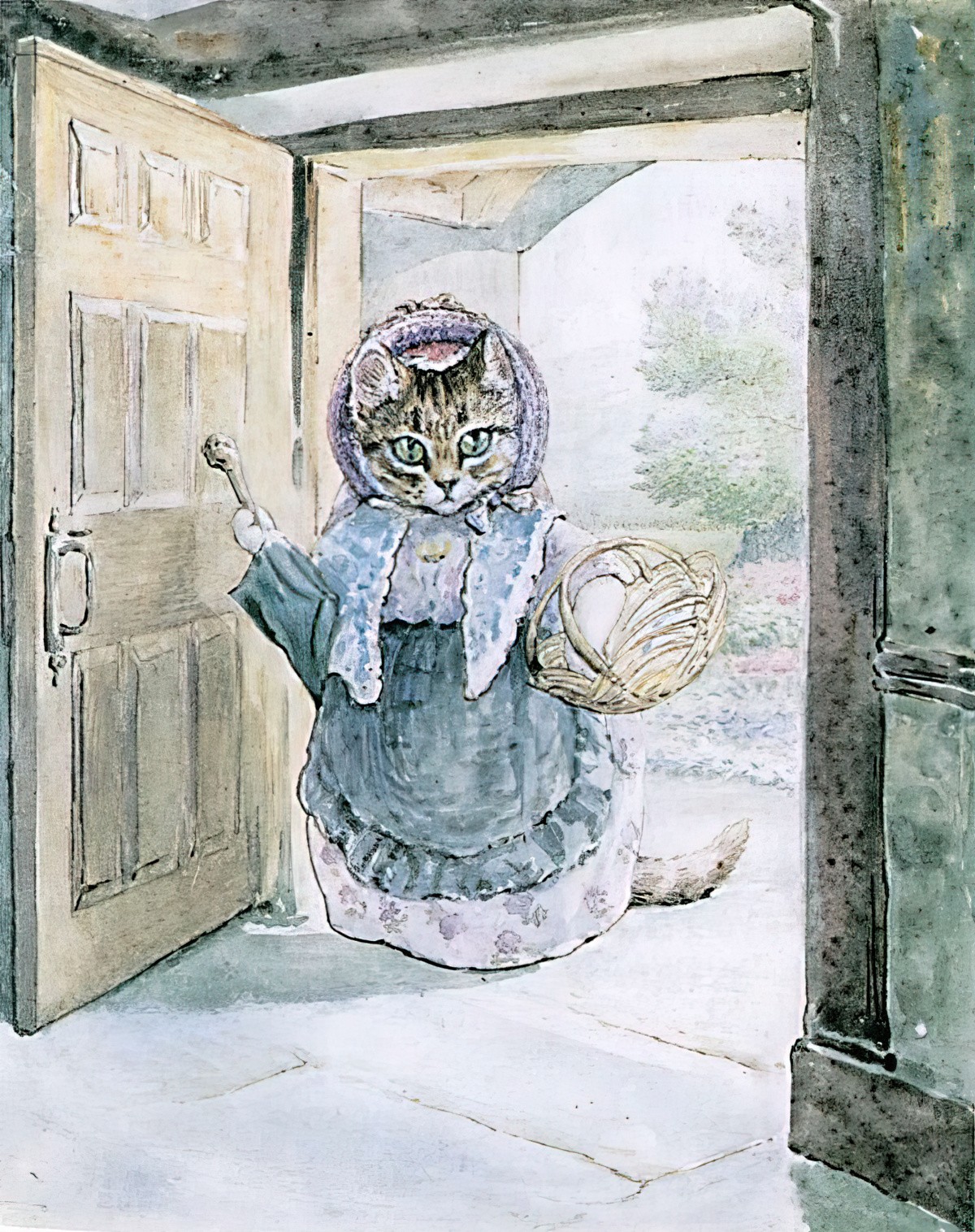
DESIRE
The kittens want to have fun; their mother wants to keep them out of mischief; the rats want to make a roly-poly pudding out of one of the kittens; John Joiner the dog wants to complete whatever job he’s charged with.
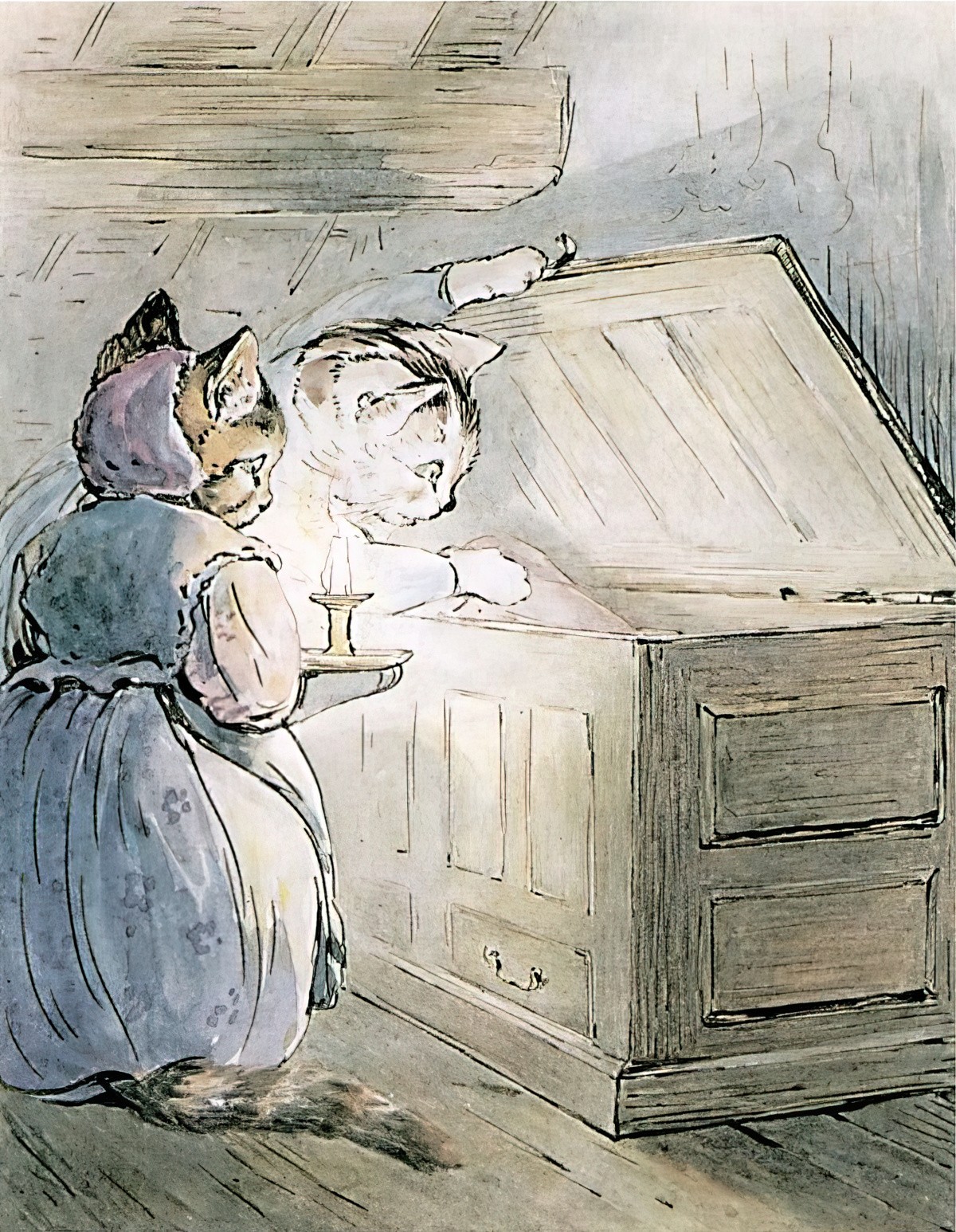
OPPONENT
Parents and children are natural opponents — the kittens want to make mischief; Tabitha wants to know where her children are.
This house is also infested with rats. Functionally, these rats are the ghosts which haunt the big house — I’m thinking of a film such as The Others. You sort of know they’re there, but you only hear them scuttling. There’s a veneer between the two worlds.
The ‘old father rat’ is the most fearsome rat of all. He has yellow teeth and is too much for the cats. He appears occasionally like a ghost. He steals the rolling pin and pats of butter.
According to the other kitten, there is also an old woman rat who steals dough.
The reader should deduce at this point that the rats are stealing supplies to make their own pudding. It’d be easier on the rats if they simply waited for the cats to make the pudding and then steal the entire thing, but perhaps they like it made a certain way?
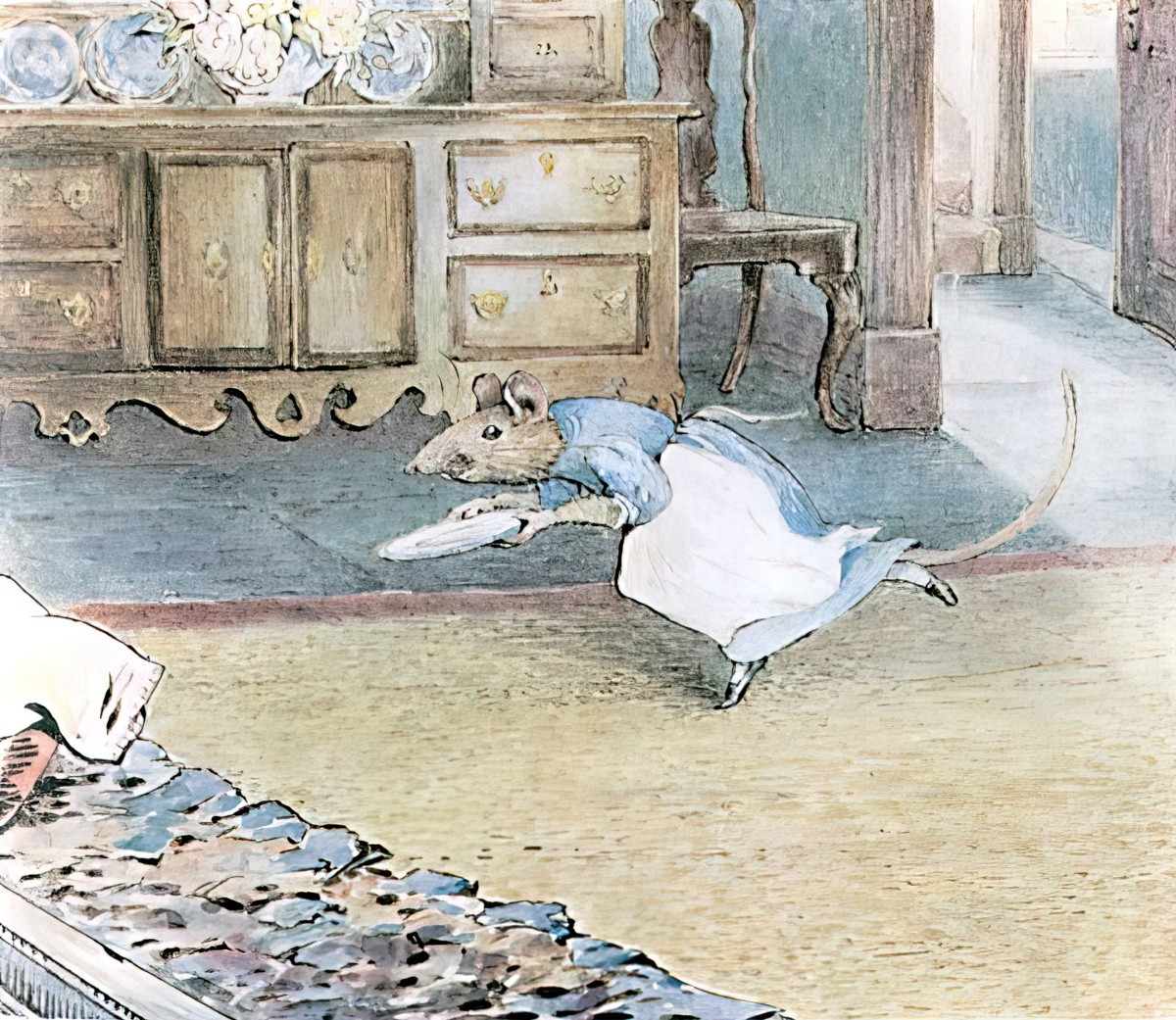
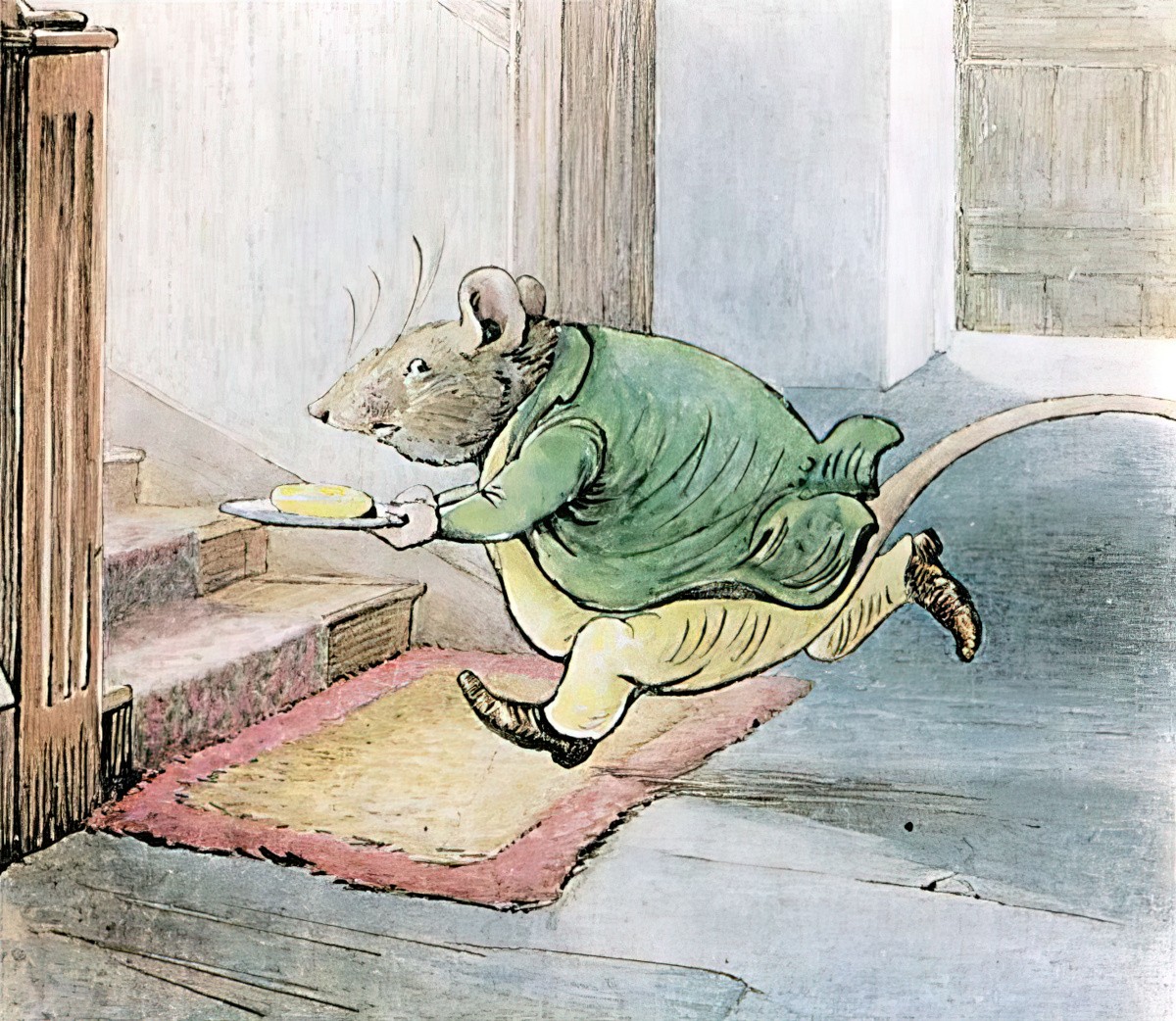
PLAN
While their mother was searching the house, Moppet and Mittens had got into mischief.
The cupboard door was not locked, so they pushed it open and came out.
Half the time when good guys get locked in a cell, all of the equipment that they need to escape is in the cell with them.
TV Tropes, Locking Macgyver In The Store Cupboard
Tabitha goes off looking for her kittens. This is where the spatial horror is introduced:
It was an old, old house, full of cupboards and passages. Some of the walls were four feet thick, and there used to be queer noises inside them, as if there might be a little secret staircase. Certainly there were odd little jagged doorways in the wainscot, and things disappeared at night—especially cheese and bacon.
SPATIAL HORROR
As if old houses aren’t creepy in their own right, the creepier thing about them is that you can get lost in them — not just in the rooms themselves, but in the spaces between.
The Rats In The Walls, as well as Neil Gaiman’s The Wolves In The Walls encapsulate this particular fear. A Lovecraftian fear of passages, corridors and spaces in between may be more common than I realise. Jeff Kinney even makes a gag out of it in Wrecking Ball (2019). Greg can’t stand the thought of creatures poking about in the walls, so his future dream house will be made entirely of glass. The illustration shows Greg sitting downstairs, looking straight through the floors into an upstairs toilet.
Point of view switches to the kittens — stand-in children for child readers. Moppet and Mittens are all about mischief. That’s their ‘plan’. They are playing bakers, making ‘dear little muffins’ out of dough.
Point of view switches back to the adult cats. Cousin Ribby has arrived. The two adult cats lament the mischief made by kittens. It is revealed that Thomas has gone missing. Together the lady cats search.
Now there’s another sequence of spatial horror, with Tom Kitten stuck in the chimney of an old house, ‘where a person does not know his way, and where there are enormous rats. [Cats are not people, but we are not supposed to think about that.]
It was most confusing in the dark. One flue seemed to lead into another.
There was less smoke, but Tom Kitten felt quite lost.
Eventually, John Joiner the dog is brought in to sniff Tom Kitten out.
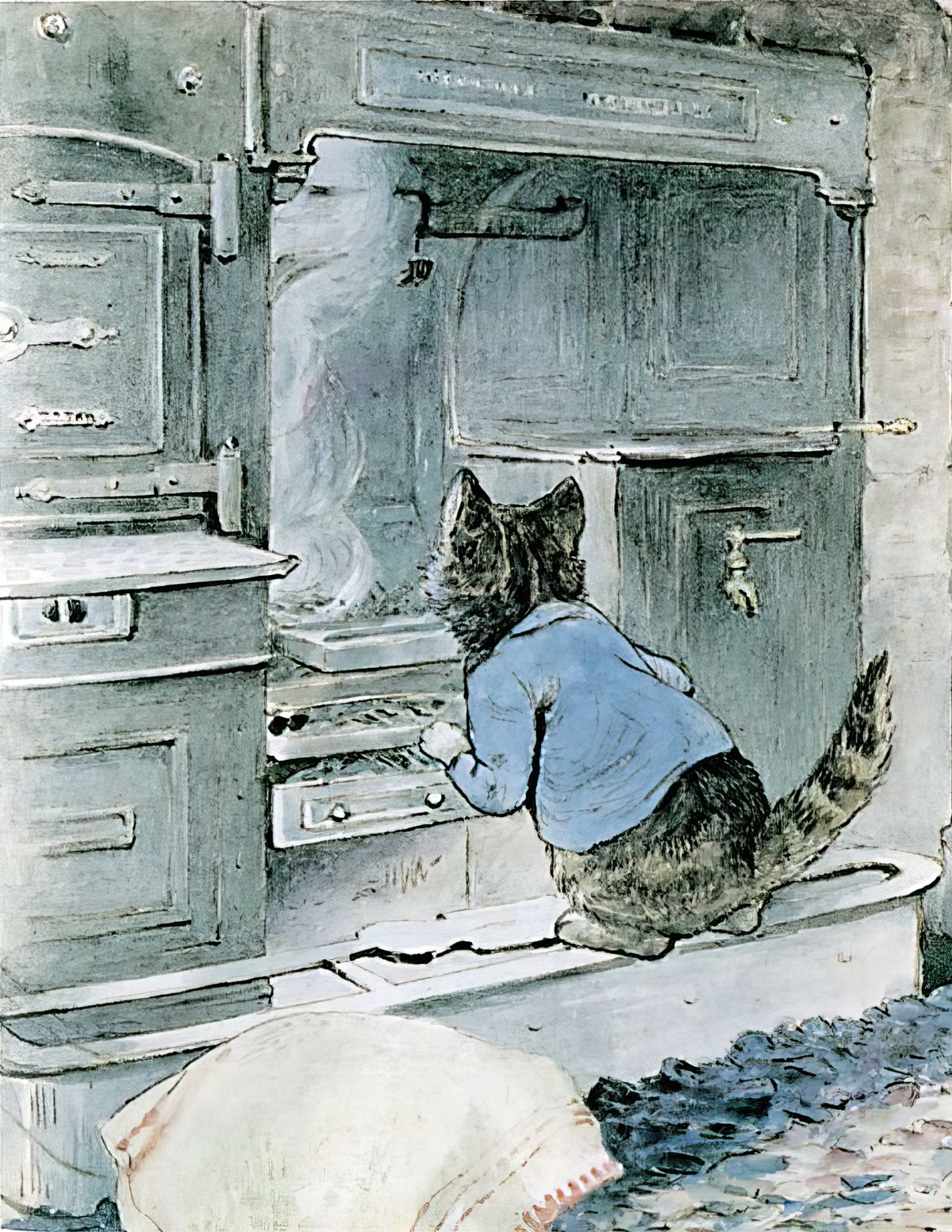
BIG STRUGGLE
The Battle between Tom Kitten and the rats culminates in that horribly memorable image of the kitten inside the dough. The build up is reminiscent of fairy tales such as Jack and the Beanstalk, where a formidable male creature orders his wife to make him a very particular sort of meal — one which includes our main character:
“Anna Maria,” said the old man rat (whose name was Samuel Whiskers),—”Anna Maria, make me a kitten dumpling roly-poly pudding for my dinner.”
“It requires dough and a pat of butter, and a rolling-pin,” said Anna Maria, considering Tom Kitten with her head on one side.
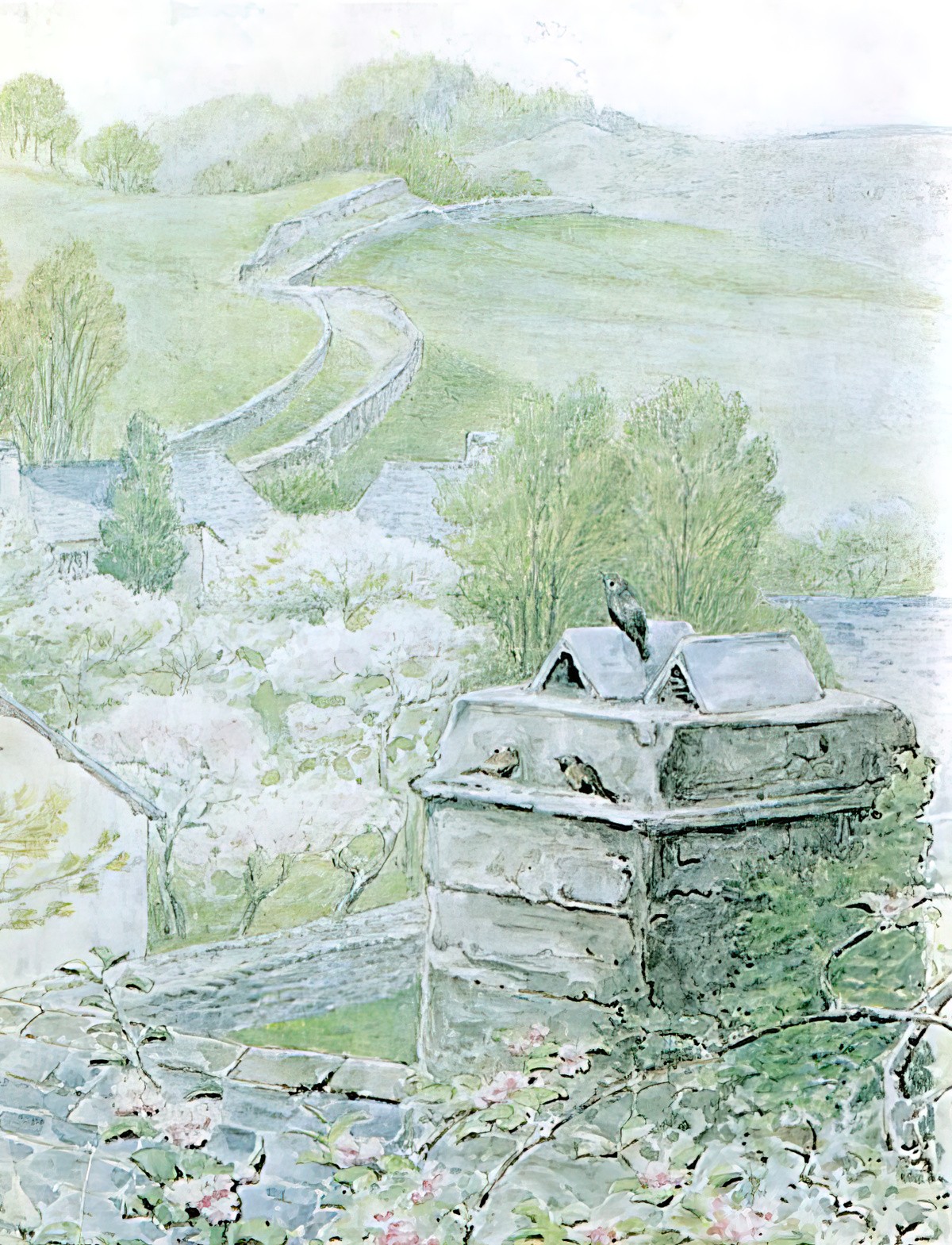
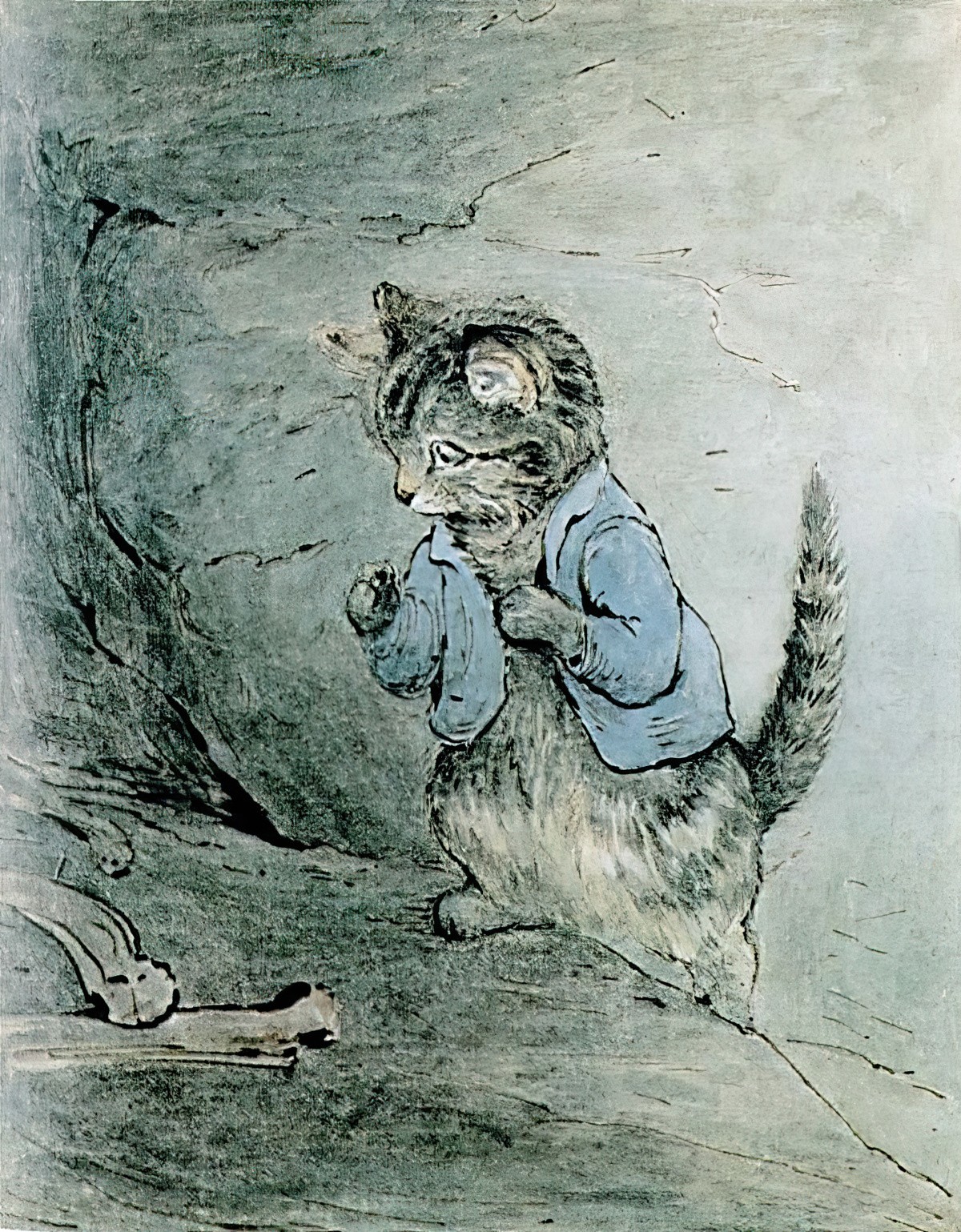
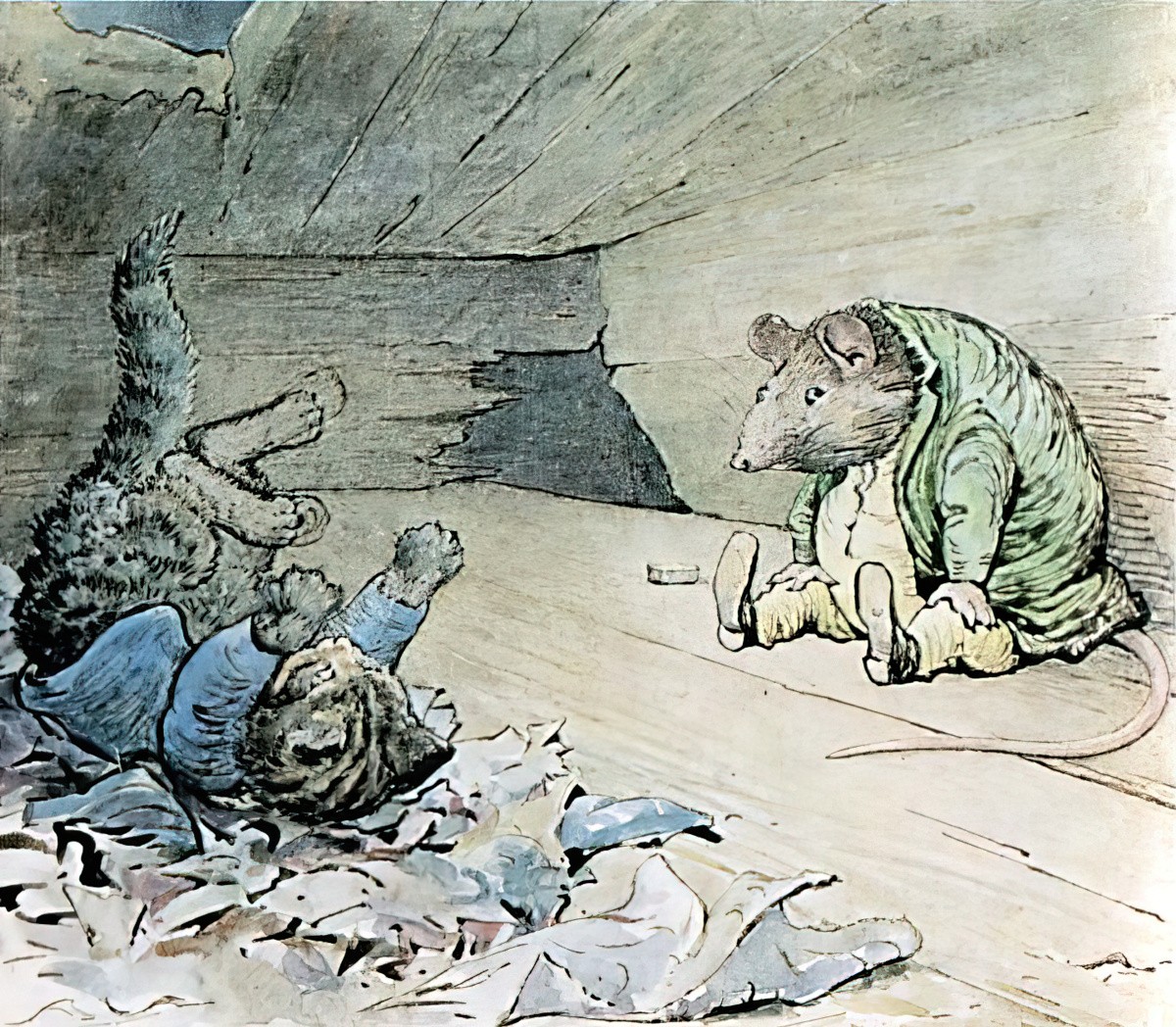
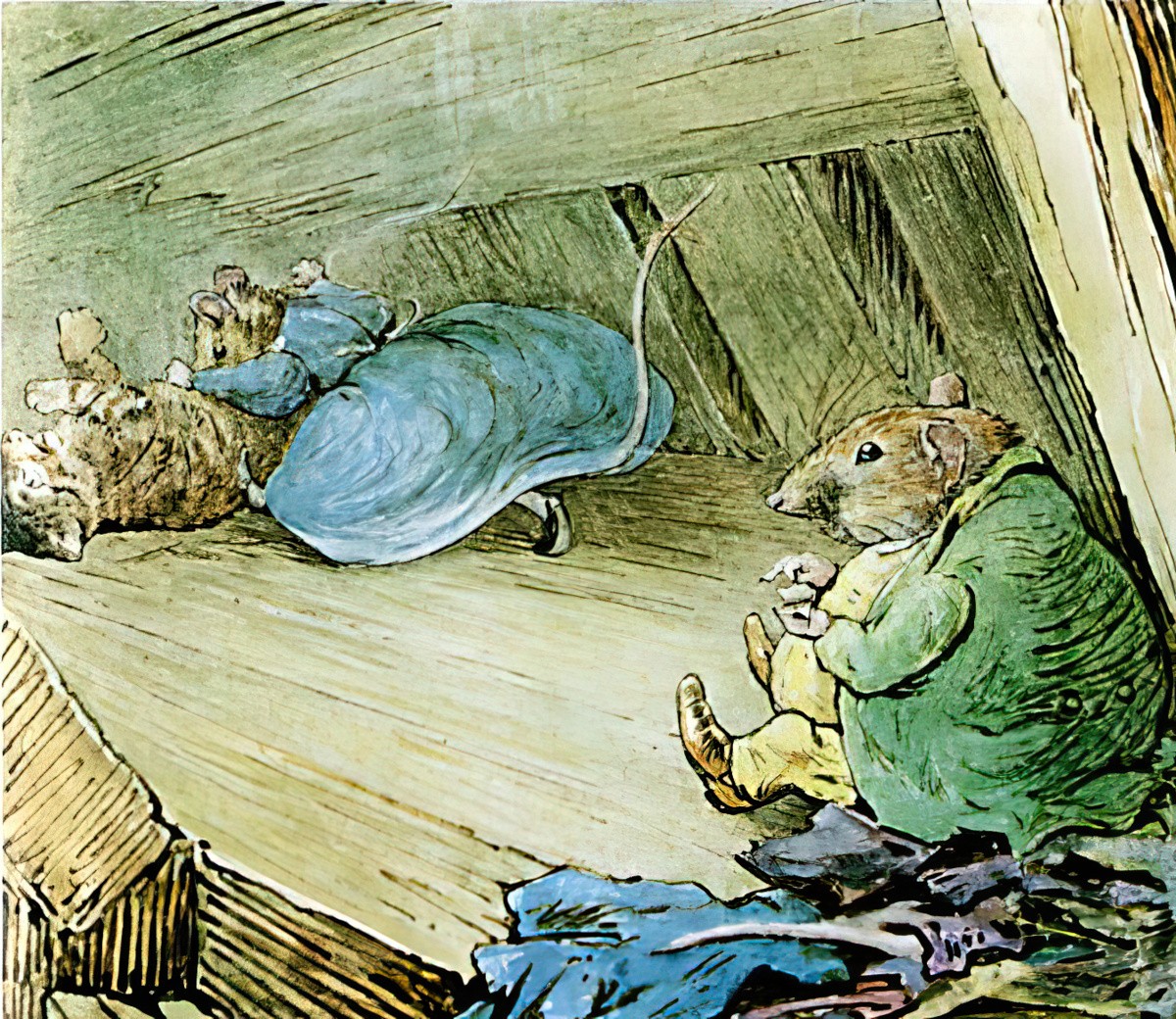
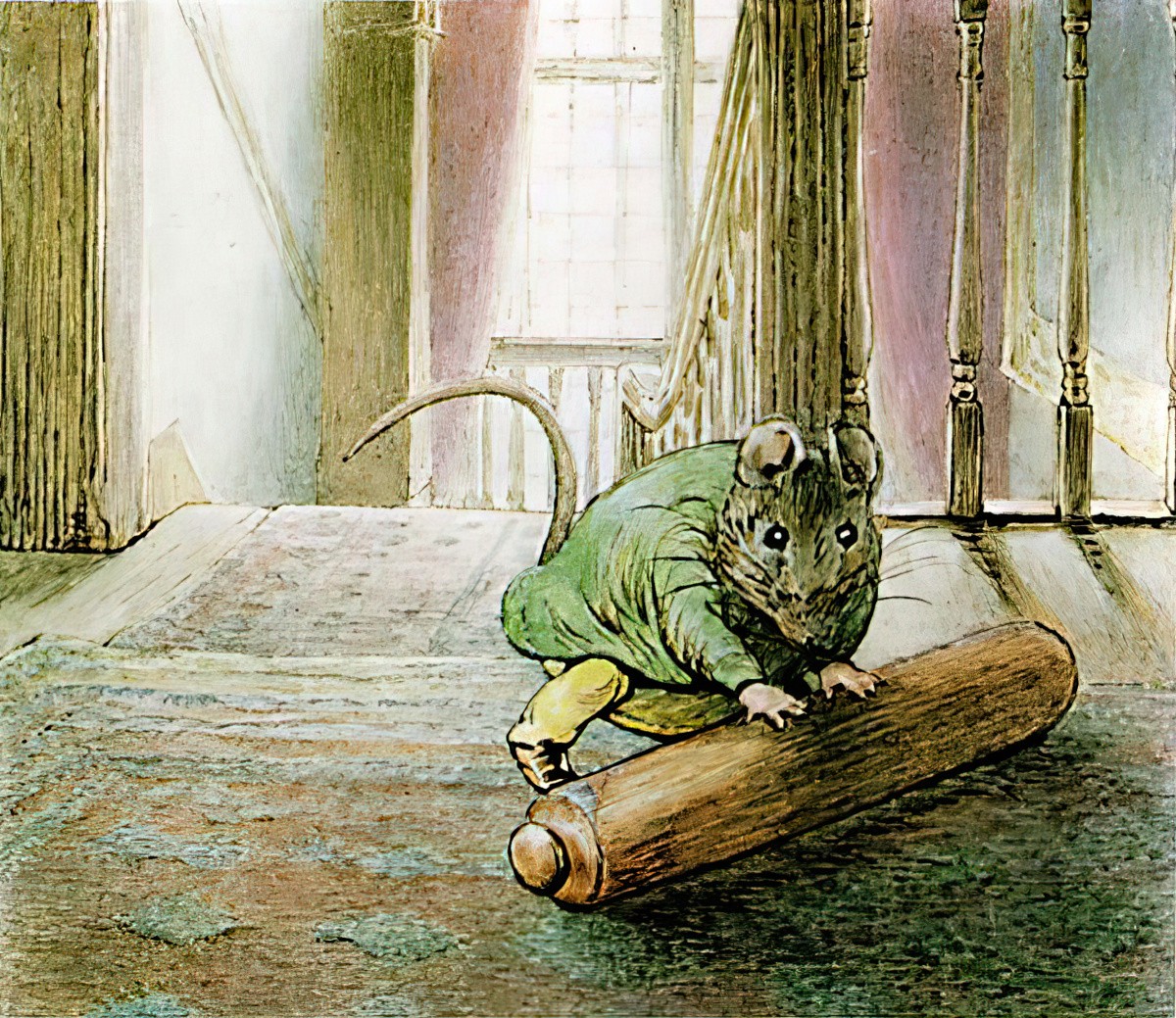
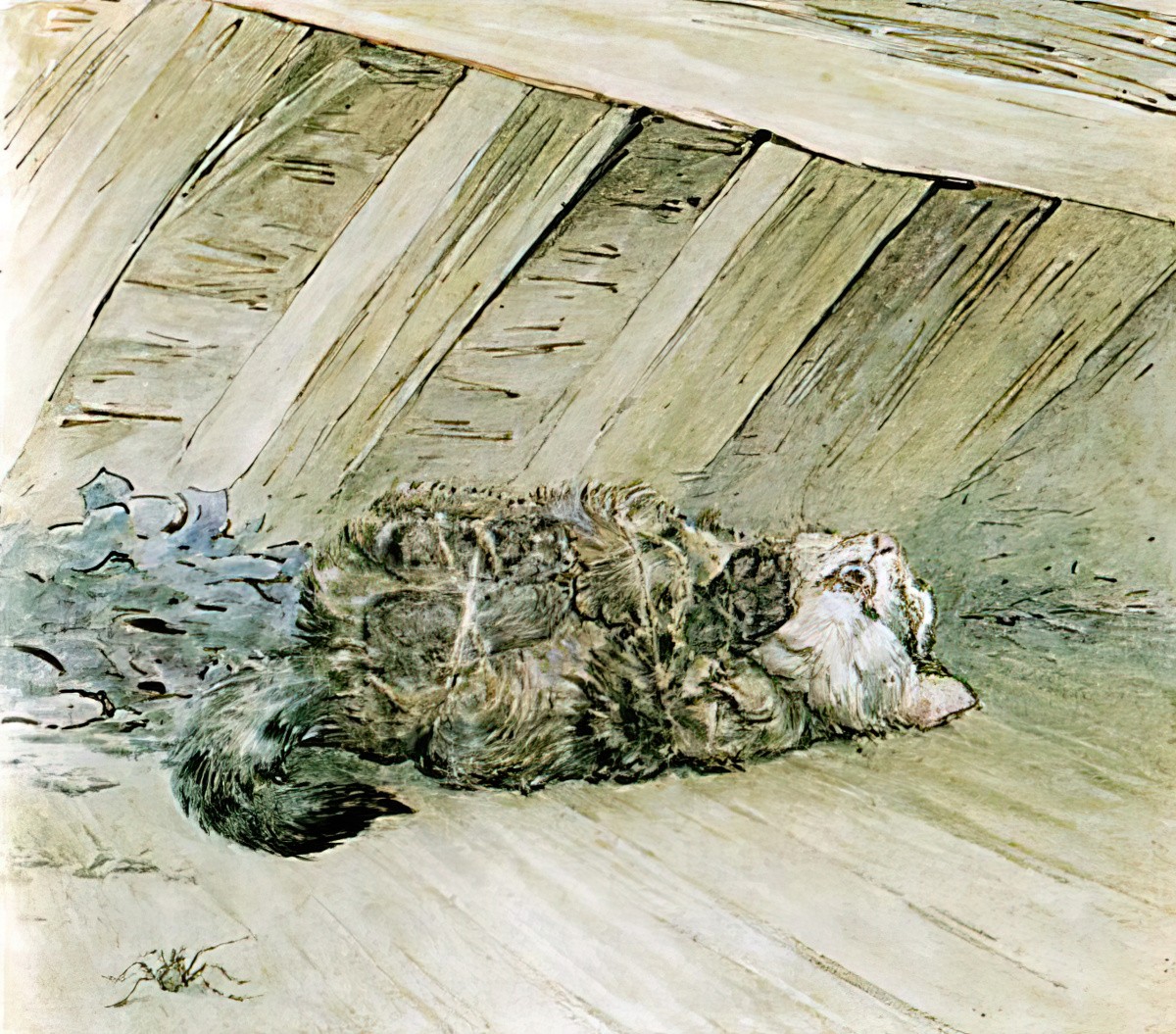
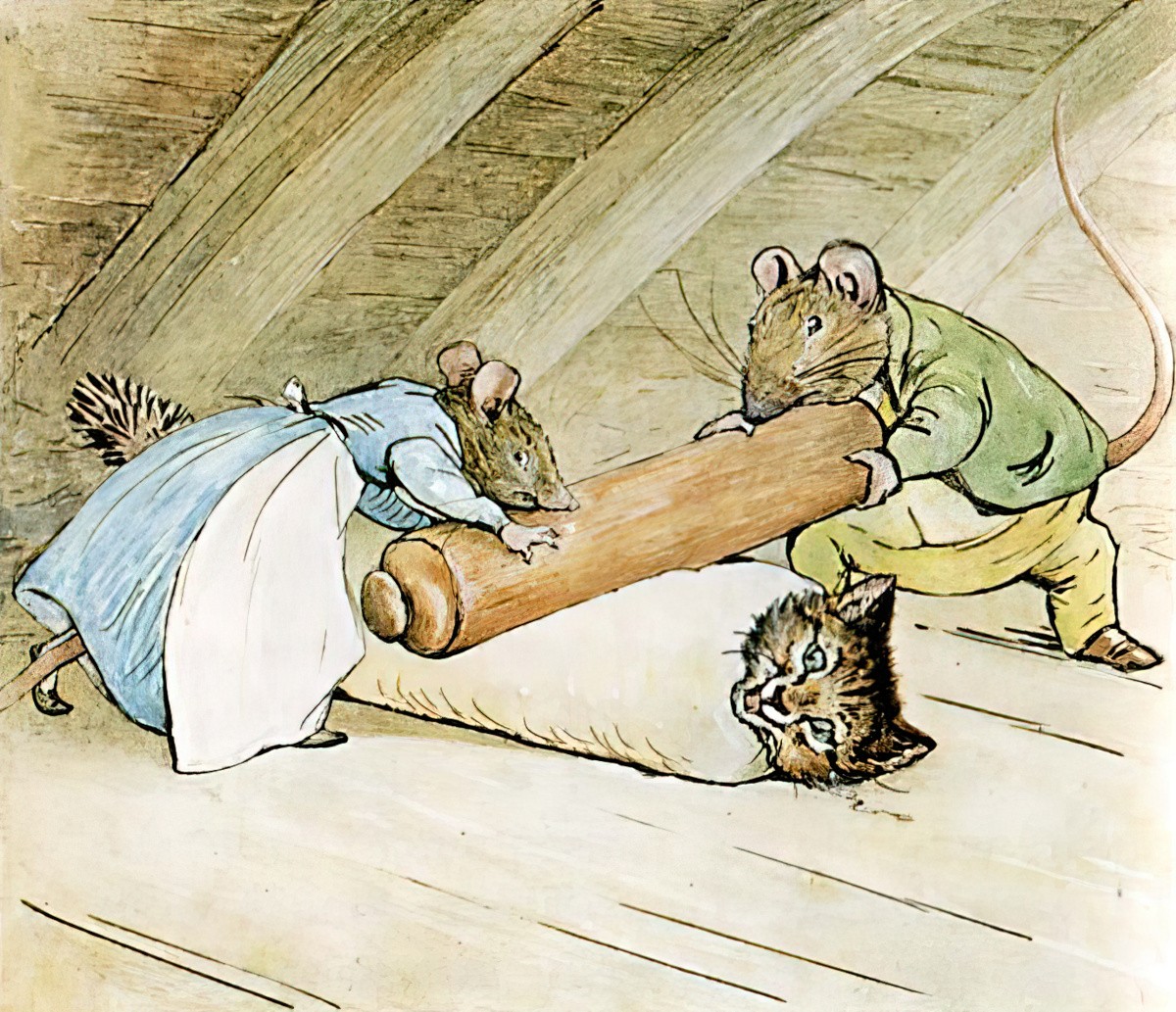
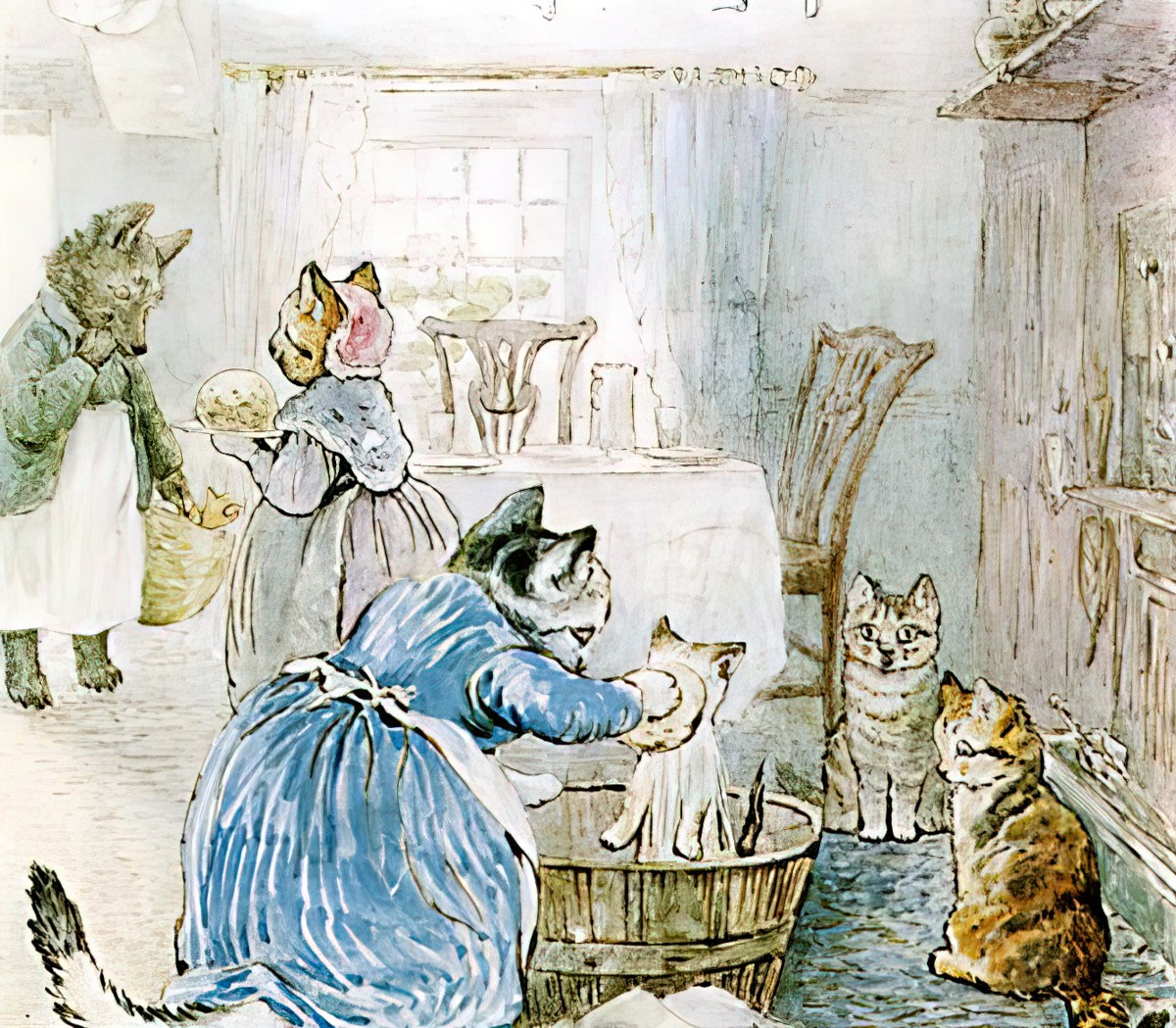
ANAGNORISIS
There is no anagnorisis, unless you count the fact that Samuel Whiskers and Anna Maria have realised they cannot remain in the house.
The plot is resolved when John Joiner finds Tom Kitten by sniffing around and through the cracks in the floorboards. John Joiner is a dog, who has been called in by the cats to help.
This is where the most horrifying part of the story ends.
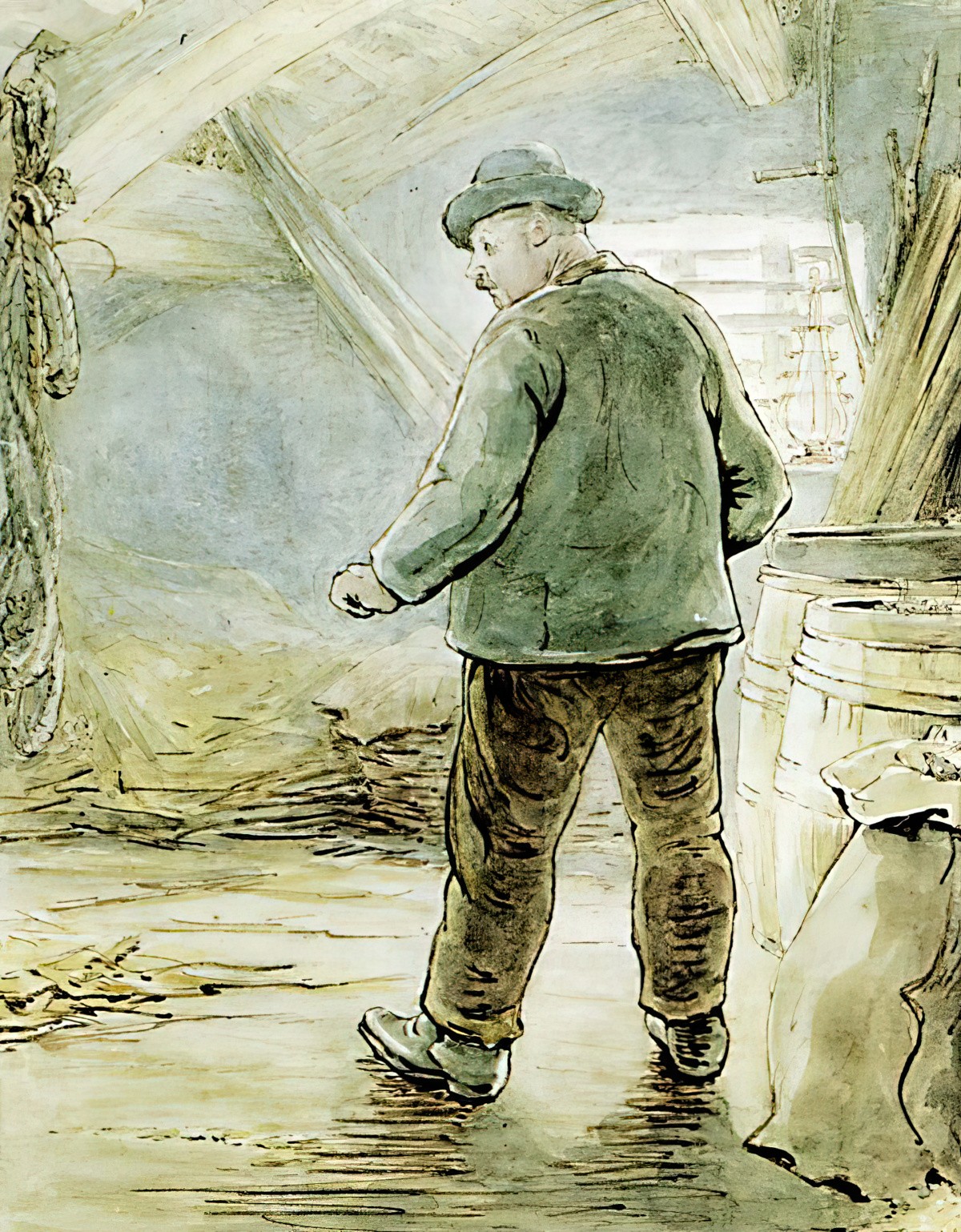
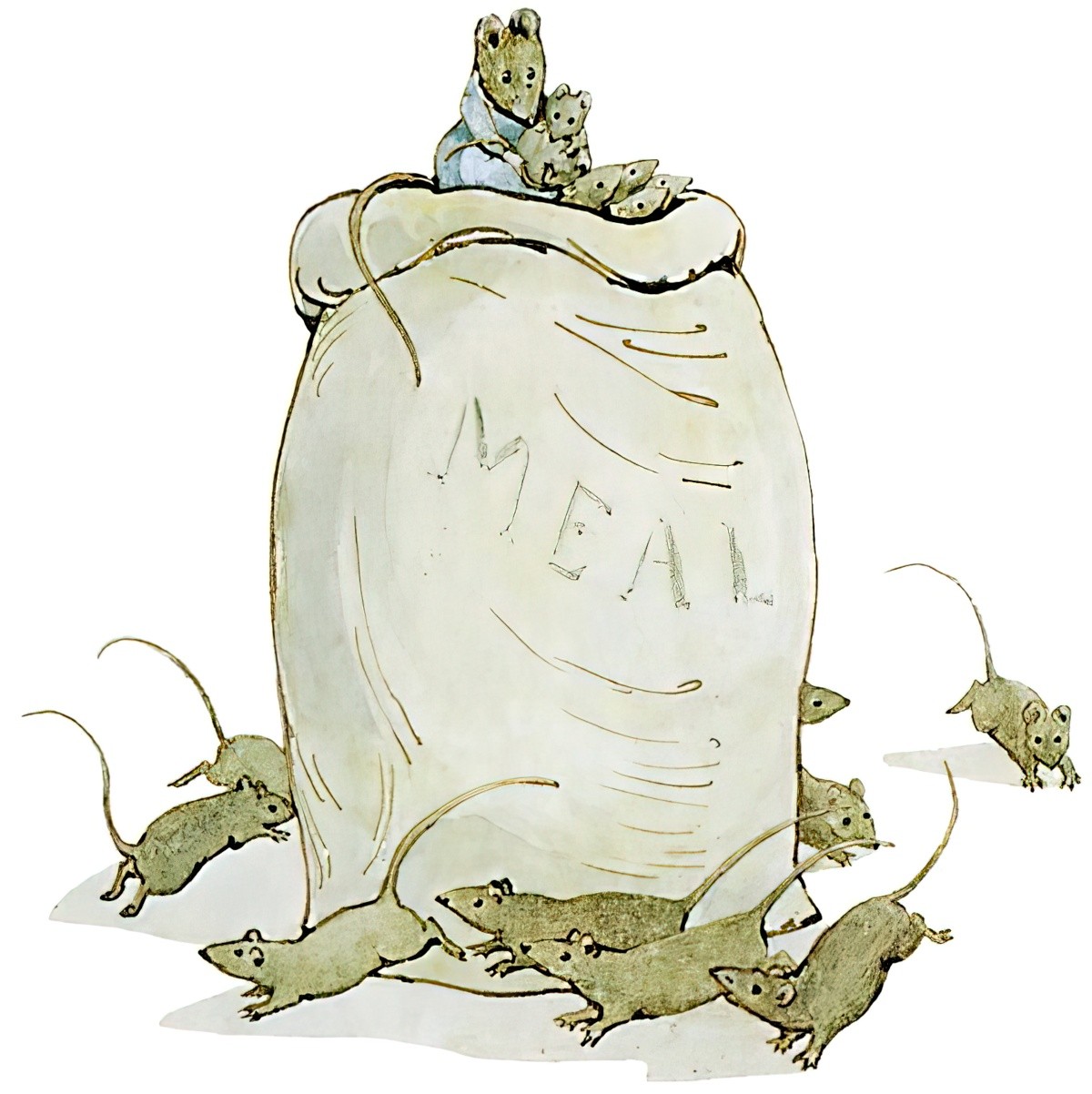
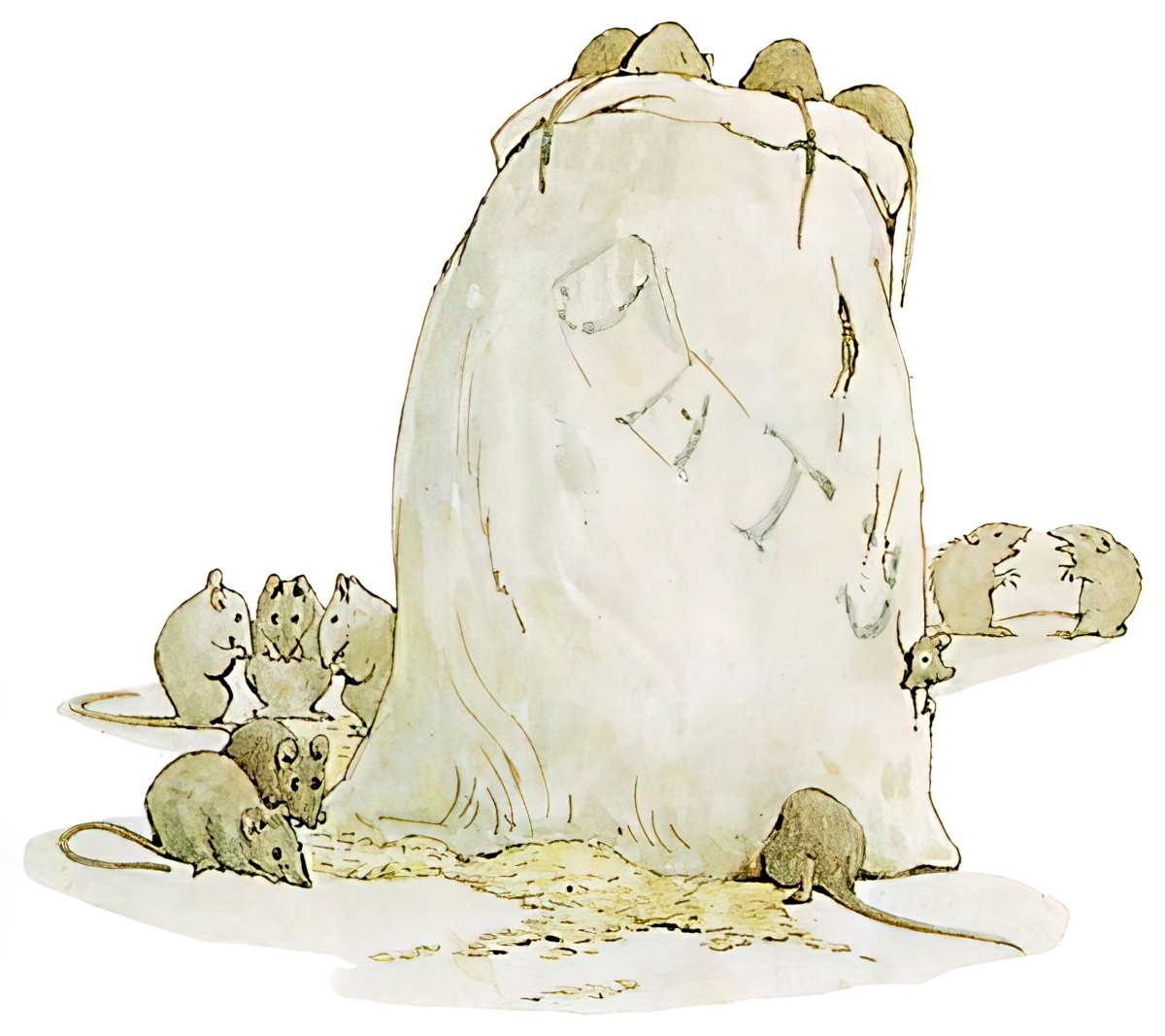
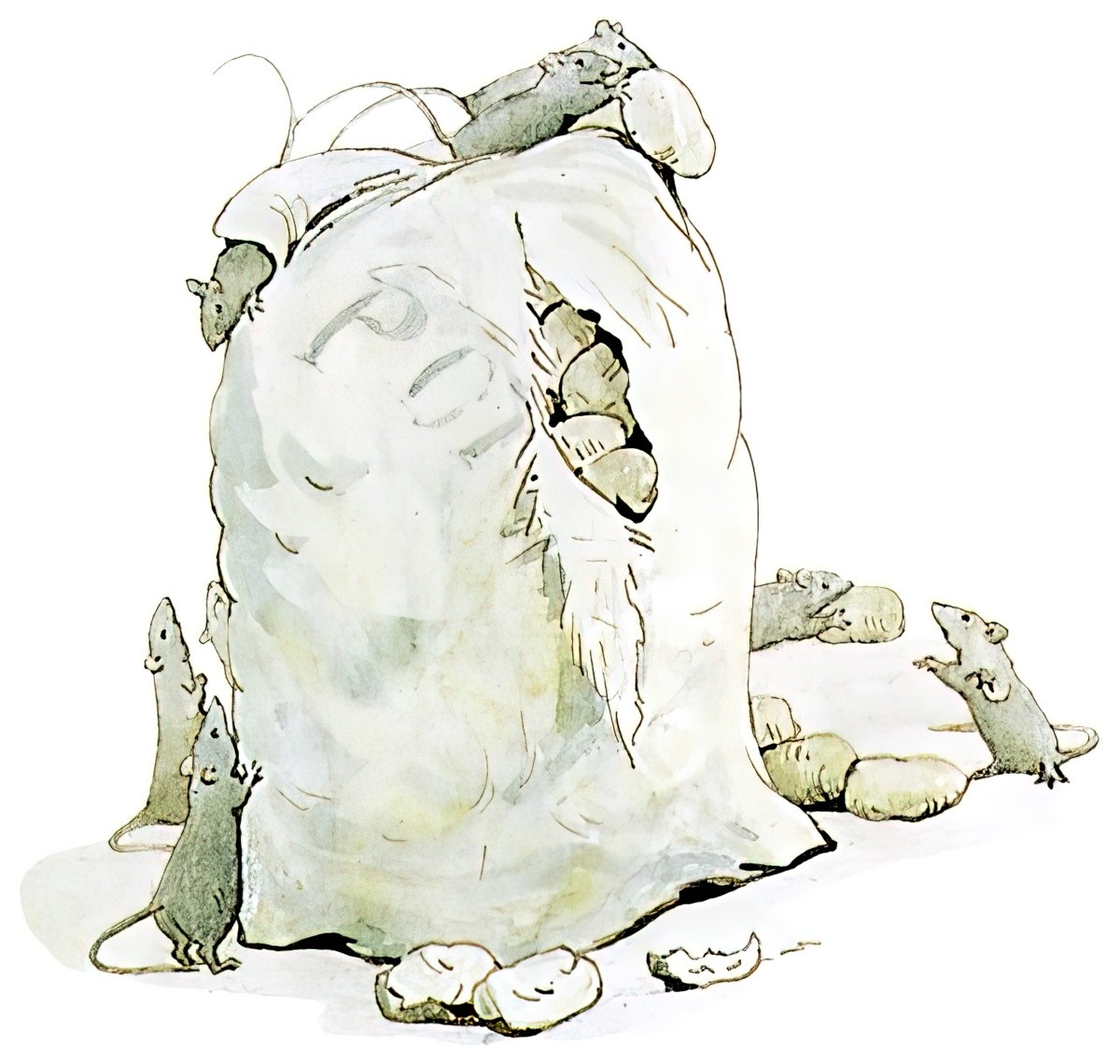
NEW SITUATION
But Potter adds a cosy addendum to the end of this story, bringing herself as narrator. She tells the reader how the carpenter dog cannot stay for tea with the cats because she herself has charged him with the task of building chicken coops.
And in a comic twist, Beatrix Potter sees the evil rats running off with her wheelbarrows. They have piled their luggage into the wheelbarrow and are moving into Farmer Potatoes’ barn (presumably because of the dog, though they haven’t been scared of the cats). They do very well in the barn and all the rats there today are descended from Samuel Whiskers and Anna Maria.
Moppet and Mittens grow up into ‘very good rat catchers’. They earn their living as such, tacking tails onto the wall as proof. This in itself is a horrifying scene to me.
But Tom Kitten is forever scared of anything bigger than a mouse.
